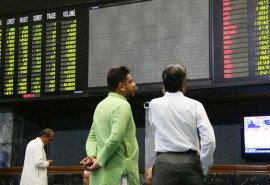
The gap between federal spending and annual tax collection has been a troubling factor for Pakistan’s economy and public finance.
Over the past decade, this issue did not draw the attention of most economists and journalists. They tend to ignore the painful fact that from fiscal year 2005-14 the gap swelled from Rs111 billion to Rs2.2 trillion.
All problems in public finance and the real economy start from the widening gap between resources and spending at the federal level. This spending becomes unbridled in the absence of democratic checks supposed to be applied by parliament, the media and legal institutions. These are the institutions that help restrict spending by utilising instruments of audit and accountability in most countries that achieve progress and democracy simultaneously.

Take a look at the statistics provided by periodical reports of the Ministry of Finance and the Federal Board of Revenue (FBR). Tax collection for fiscal year 2005-06 was Rs704 billion, whereas total current expenditure stood at Rs826 billion. The spending was higher than the tax collection by only Rs122 billion (roughly 17%).
On the other hand, total tax receipts for fiscal year 2014-15 were Rs2.3 trillion against total current expenditure of Rs4.5 trillion, which was almost double.
Every other day newspapers and news channels pick up stories from different branches of the economy and relevant regulatory institutions to point out how these suffer from perennial underperformance and delinquent practices.
But it is time that the biggest story of public finance is picked up for analysis and projection. This may help nudge parliamentary and legal institutions to do something for devising effective instruments in order to keep a check on plucky spending.
Such an effort should, however, be reinforced by a reasonable increase in tax-driven revenues to a point that the gap is bridged not only by spending cuts but also by an upswing in revenues. Only this can help in achieving a meaningful increase in development allocations. This is meant to inject more capital into vital projects for the country’s physical and social infrastructure.
But such a process starts with serious curbs on spending in the areas where the application of controls sparks public applause.
The figures quoted above tell the story of waywardness which most economic analysts tend to ignore while commenting on fiscal performance of the country. Come April and the process of budget-making – the federal budget is due in mid-June – gets under way in the light of inputs provided by the trade, industrial and agriculture sectors.
Like each year over the past decade, questions about tax rates would be asked but not about the mindless spending by the state. Neither would there be radical proposals for bridging the spending-revenue gap and poor allocations to the critical development projects in the social sector and physical infrastructure.
Ignoring tax evasion
Pakistan earned disrepute for choosing to be a nuclear power and still being deficient in energy despite possessing natural resources. Choosing to sleep over tax non-compliance and plucky evasion, the managers of public finance over most of the past decade appeared to be ignorant about the four integral aspects of responsible management – taxpayer facilitation and correct assessment, the carrot-and-stick mechanism, data analysis for detecting evasion by the already registered and potential non-compliance.
The taxable income-earning segment of the population is pretty tiny on the tax ledgers, though a substantial income-earning demography has surfaced over the past decade, as indicated by the expanding market of real estate, newly set-up trade and industrial projects and the banking sector’s expansion.
If one could rely on the data available outside the official strongrooms, these indications trigger a common impression that the total income taxpayers are only 1.7 million out of a population of 180 million (about 0.5%).
Relevant authorities have never come out with figures exposing the potential unregistered but taxable population and the increasing numbers of non-compliant staying away from the turnover ledgers.
The annual tax deposited by the registered 1.6 million out of the total 1.7 million is on the average Rs21,000. Their declared annual income does not exceed the Rs500,000 threshold. This tax-stealing majority is helped out in an atmosphere where neither the facilitation nor the data-based monitoring can create an effective carrot-and-stick mechanism.
The number of those depositing the major amount (about Rs300 billion annually) in income tax is 100,000. These are shocking figures for any observer of public-finance management, but nothing nudges the policymakers and the implementing machinery.
The writer has worked with major newspapers and specialises in analysis of public finance and geo-economics of terrorism
Published in The Express Tribune, April 6th, 2015.
Like Business on Facebook, follow @TribuneBiz on Twitter to stay informed and join in the conversation.


1731454275-0/Martha-(2)1731454275-0-165x106.webp)
1731451969-0/Trump-(4)1731451969-0-165x106.webp)













COMMENTS (4)
Comments are moderated and generally will be posted if they are on-topic and not abusive.
For more information, please see our Comments FAQ